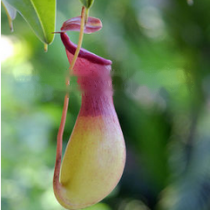
Chinese name: Nepenthes jacqueline
Binomial: Nepenthes jacquelineae
Kingdom: Plant Kingdom
Class: Dicotyledon Class
Order: Dianthus
Family: Nepenthes
1. Morphology of Nepenthes jaguilin
Nepenthes jaguilin Grass is a vine, the diameter of the stem veins is no more than five millimeters, the length can grow to five meters, and it is cylindrical. The distance between nodules can be maintained at about ten centimeters. The leaves basically have no petioles and are leathery. Oval to spoon-shaped in shape, capable of growing to twenty centimeters and six centimeters wide. There are three longitudinal veins on both sides of the midrib. The vines can grow up to thirty centimeters in length. Ground and lower cages are usually smaller, rarely exceeding 6 cm high and 4 cm wide. Funnel-shaped, occasionally missing wings. The lips are broad and flat, with a narrowed front, not more than 10mm wide. Except for the front part of the lip, the other parts of the lip ribs are not obvious. The upper cages are larger, up to 15cm in height and 10cm in width. Wings at the front of the pitcher degenerate and shrink.
2. Habits of Nepenthes jaguilin
Nepenthes jaguilin is endemic to the Barisan Mountains in western Sumatra. More specifically, it is only found in the West Sumatra province of Indonesia. It is usually an epiphyte, but occasionally grows on the ground. It is distributed in areas with an altitude of 1700~2200m. The native habitat of N. jacquard is usually dense sphagnum forests, often cloudy and rainy. Therefore, the air humidity is quite high, and the climate is cool. Due to the occlusion of clouds and vegetation, the light received by Nepenthes jacquard is not strong. Seedlings of Nepenthes jaquiline are quite sparse in their native habitat. This shows that its resistance stability is rather low. And because of the peculiar appearance of insect traps, it is more vulnerable to the threat of over-collection.
3. Cultivation of Nepenthes jaguilin
Nepenthes jaguilin can be cultivated in the greenhouse. Planting can be used to improve the environment according to the needs of pitcher plants. Improve the environment that is not suitable for the growth of pitcher plants in the planting environment. The basic requirements for Nepenthes to grow are: light, moisture, humidity, temperature, nutrients and growth substrates. Light is one of the most important factors in growing large and brightly colored insect traps. Provide enough air humidity, moderate soil moisture and sufficient light to make the leaves turn red like red wine. Plants can be acclimated to receive some direct sunlight, preferably morning sun. The requirements for the moisture content of the cultivation medium are not high, and Nepenthes generally prefers a cultivation medium that is too humid and airless. Unlike other carnivorous plants that only need to keep the soil moist during the growing season, when planting pitcher plants, the soil needs to be kept moist at all times. The substrate should preferably be loose and not able to squeeze out water. Therefore, the method of watering is more suitable for Nepenthes.
Guess you like it
Hyacinth | Other side flower | Lily | Peach blossom | Plum blossom | Orchid | Chrysanthemum | Clivia | Lotus |
Pueraria | Peony | Eustoma | Frangipani | Calendula | Purple Magnolia | | Smile Flower | June Snow | Cineraria | Cannonball Flower | Desert Rose | Acacia | Clivia | Smile | |Poinsettia | Dianthus | Ball Orchid | Lycoris | Cymbidium | Pansies |
![[Dog Training 5] The training method of pet dog dining etiquette](/static/img/12192/12192_1.jpg)




